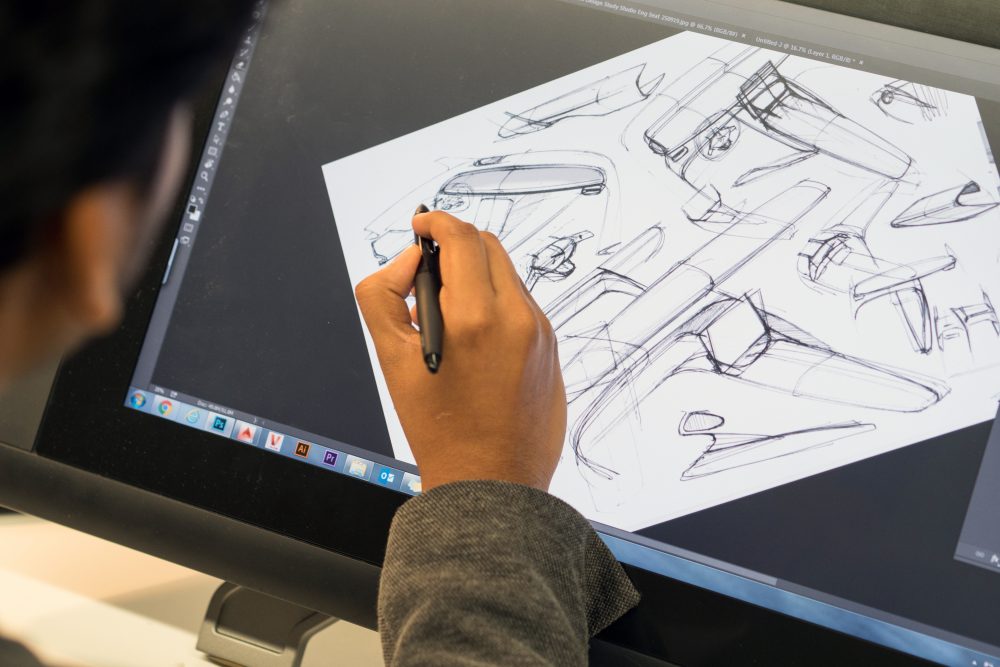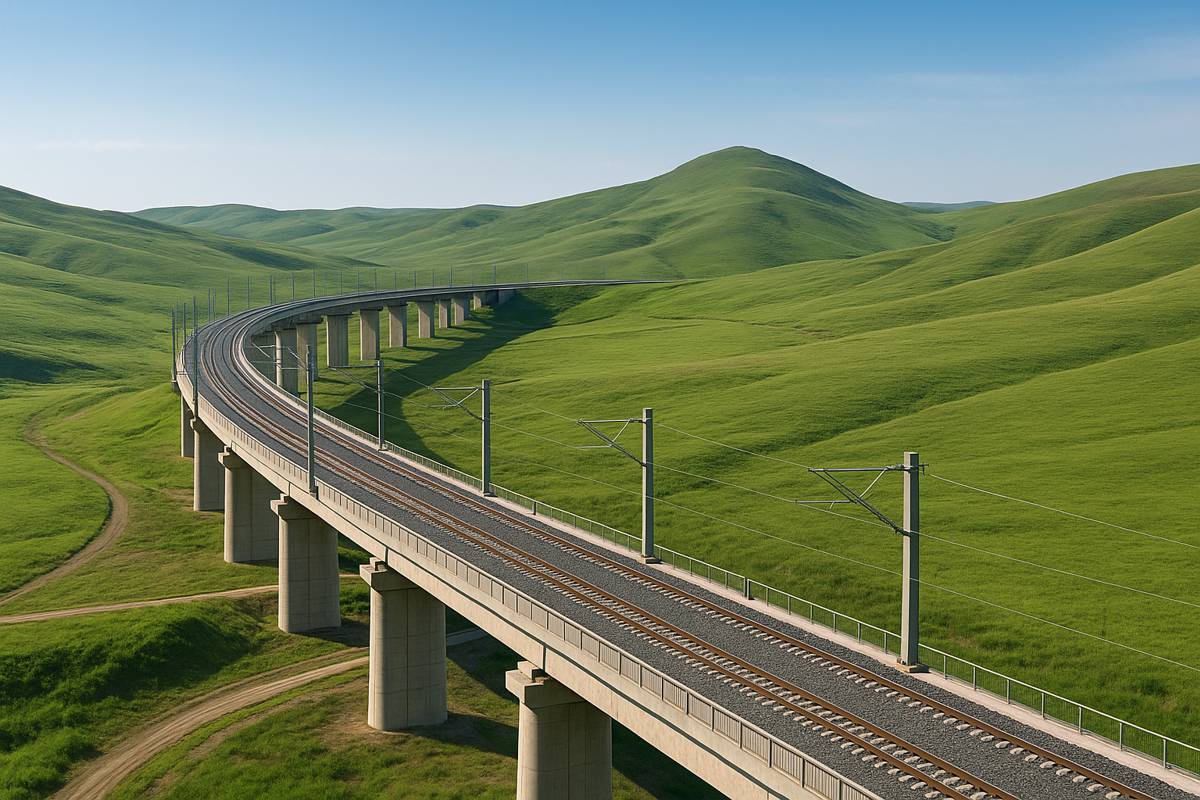Behind the scenes at the new Jaguar Design Studio
Beautiful design has always been at the heart of Jaguar; exciting proportions, elegant form and innovative luxury. Recent World Car Design of the Year awards for the Jaguar F-TYPE, F-PACE and I-PACE are testament to the Jaguar Design Studio team’s successful approach.
How Jaguar achieves its design leadership has always been a closely guarded secret with work happening behind closed doors in Whitley. But with Jaguar Design moving into a purpose-built studio at the Gaydon Design and Engineering Centre in September 2019, Jaguar has thrown open the doors to give a unique insight to the fascinating journey that will bring the next-generation Jaguar vehicles to showrooms – from initial sketching and clay sculpting to final engineering.
Across six-stages of the design journey the Exterior and Interior teams collaborate throughout a well-defined process that can move from inspirational first sketch to finished car in around four years. From start to finish, each project is overseen by a programme management team that ensures integration with all business functions at each of the six stages:
- Sketching
- Clay Sculpting
- Digitalisation
- Colour and Materials
- Design Technical
- Model Manufacture
1. SKETCHING – typically four years before reveal
Designers at the Jaguar Design Studio never stop sketching. Pen, pencil or tablet, the studio team is constantly generating new interior and exterior ideas for future products. Hundreds of sketches are produced each day.
The design process for a future Jaguar starts with an internal competition. Designers – from across the studio – are tasked with producing their best sketches and creative ideas before entries are gradually whittled down through shortlist reviews.
Adam Hatton, Exterior Design Director, Jaguar said: “We believe Jaguar sits at the pinnacle of automotive design, and we now have a very special place to achieve our goals. You always get the most creative results when a team works well together and that’s what we’re all about. We care about our design team. We wanted to give them the best environment to work in, and we take time to nurture our designers so they can evolve their very best ideas, starting with the creative sketching process.”

On each project, up to eight exterior key sketches will be taken through to the next stage, each demonstrating a different theme and approach to convey their own unique blend of Jaguar creativity and innovation. Computer-Aided Surfacing (CAS) specialists then create a digital version of the initial renders. This data is then used to accurately mill the clay models.
In the new Jaguar Design Studio, the teams can go from a sketch to a full size clay model in only two weeks. Moving quickly into a physical three dimensional model is very important, because Jaguar Design has always had proportion and sculpture at its heart.
The designers who sketch the ‘winning’ initial ideas stay with the project from the first sketch to the production car, ensuring the creative spark behind the original vision is maintained and refined throughout the process.
During the sketching stage, one design is selected as the ‘vision’ which is used by the design and engineering teams to outline the feasibility of the proposal, its planned dimensions, aerodynamic requirements and any regulatory conditions. These constraints are then fed back to the other design disciplines to help progress the ‘vision’.
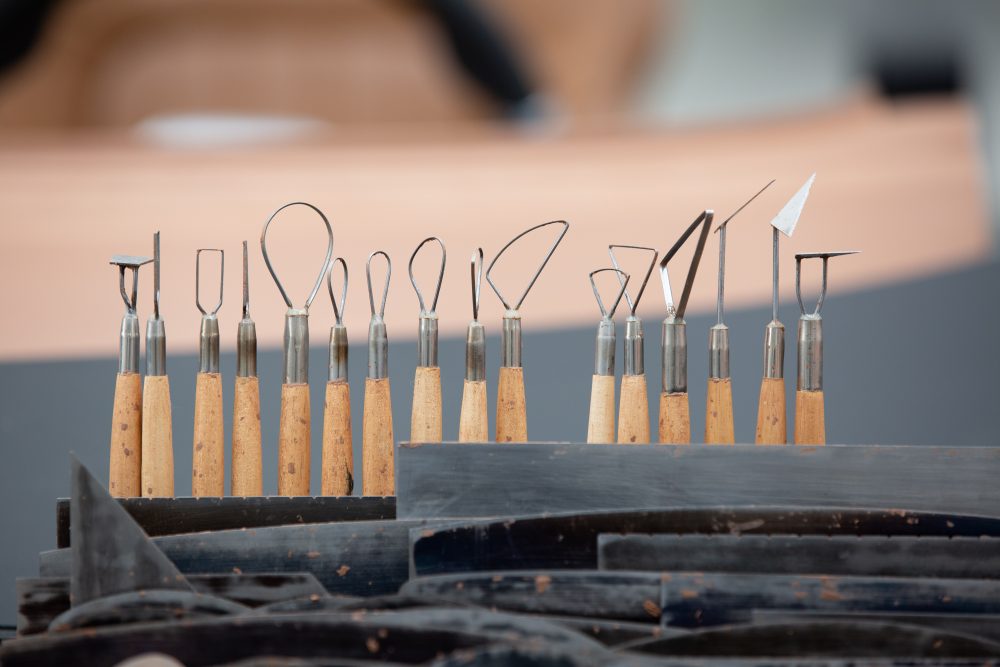
2. CLAY SCULPTING – typically four years before reveal
Clay sculpting is the lifeblood of the design studio with the sketches and engineering data turned into physical assets at this stage. An expert team of 46 sculptors, ranging from long term employees to new talent coming through apprenticeships, add the human touch – quite literally – to bring the sketches to life.
The six to eight projects that have been brought forward from the sketching phase, including the ‘vision’ proposal, have clay models created. Each of the designers is given half of a full size exterior and is paired up with a clay team to bring their vision to reality. One sculptor will focus on the front, two on the side and another on the rear, though all sculptors are capable of working on any aspect of an exterior design. Following review, three different themes will be continued into a full clay with one final design signed off for further refinements to be made.
Alongside the exterior models, individual parts like seats and steering wheels, and even full-size interiors, are also sculpted from clay.
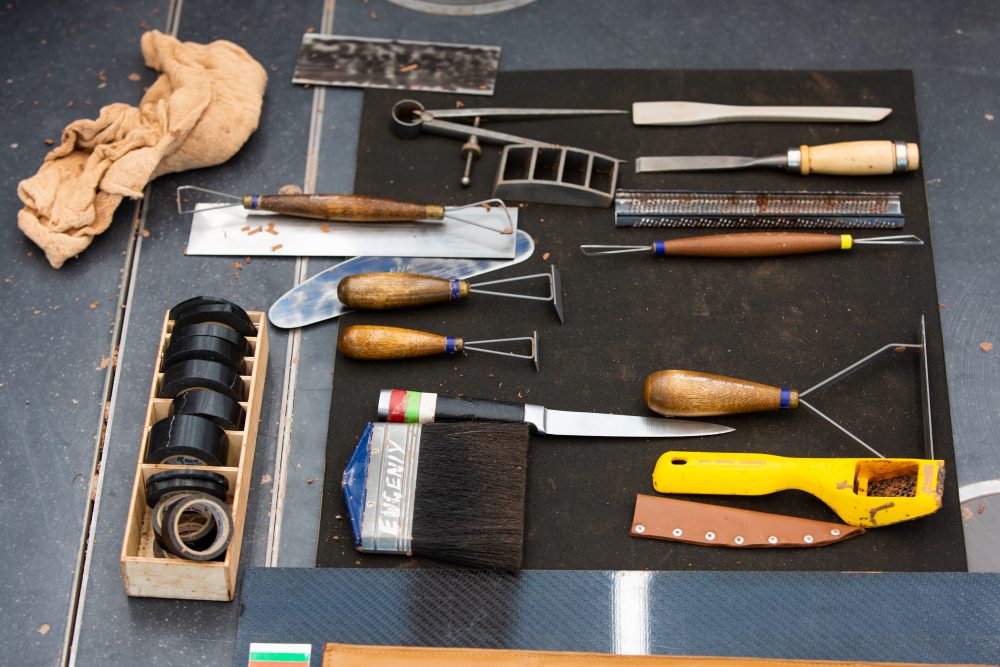
The new Jaguar Design Studio has ten clay model plates across two studio areas, each fully equipped with the latest automated milling technology and space for two full size interior or exterior models, allowing the team to work on numerous projects simultaneously. Jaguar worked with the experts at KOLB Design Technology to develop a bespoke solution to its clay sculpting facilities.
The sculpting area has 400m of custom-made floor-integrated machine rails across its ten clay milling areas, each one 20m long. Each clay model is positioned on one of 20 lifts, capable of lifting the full-size model up to one-metre and with a load capacity of 4.5-tonnes, which allows the sculptors to achieve the most ergonomic body position possible when crafting each part of the vehicle.
The system allows double-sided processing of models by the 3+2-axis Kolb Concept Line CNC clay milling machines, using the 1kw motorised spindle capable of 16,000rpm.
Each full-scale clay model comprises an aluminium chassis, foam core and, finally, up to 90mm of clay. The only part that is ‘real’ at this stage are the wheels. The clay is milled by machine using data from the CAS team before being ‘slicked’ and refined by the clay sculptors – this process can take as little as two weeks.
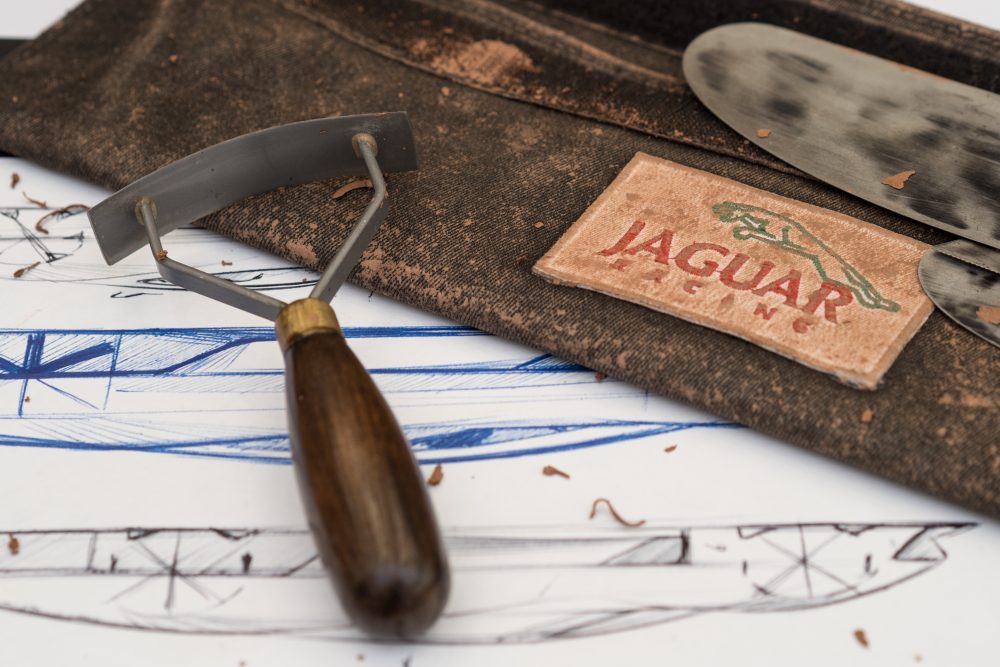
Using carbon fibre and sprung steel splines, the tools used to precisely shape the clay, the team handcraft each clay to perfect their designs. The clay models are frequently removed from the plates and taken outside to view in natural light to replicate how the vehicle will be seen on the road, and from a variety of angles and heights. This process takes much longer with revisions and adjustments made over the course of several months as each element of the design is refined and finessed to achieve a cohesive and elegant outcome.
The clay models are constantly scanned with data re-inputted to computer software to ensure engineering points are met, with clay sculptors operating to tolerances of 0.2mm. As designs are perfected, the clay models can be wrapped and painted to bring them to life. Jaguar Design utilises Virtual Reality (VR) to stitch a real-life 3D clay interior model into a digital world so designers and ergonomics experts can experience the look and feel simultaneously.
On both exterior and interior clays, 3D rapid printed parts can be produced to help bring some of the beautiful details to life quickly and at an early stage.
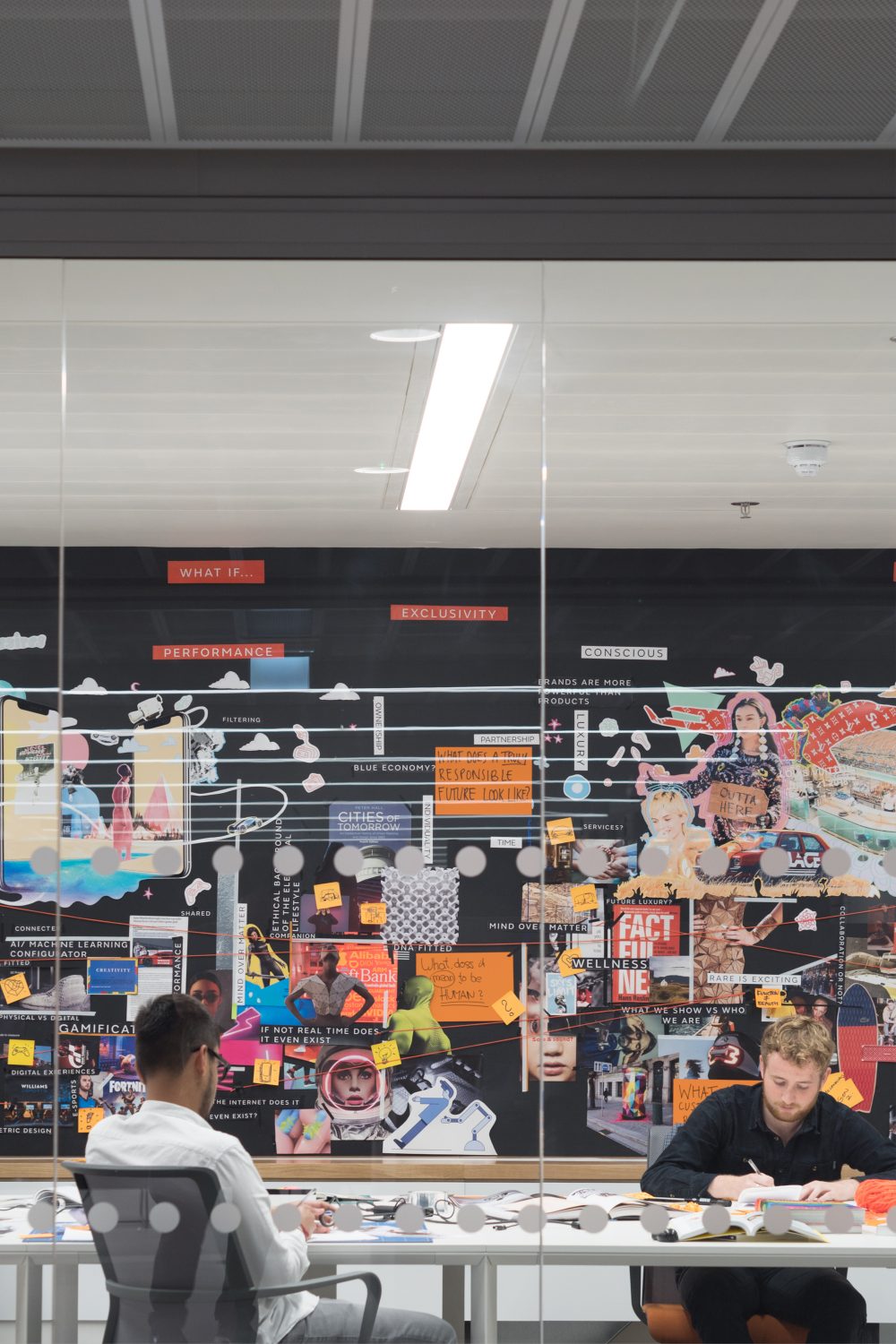
3. DIGITALISATION – throughout the design process
Digitalisation plays a pivotal role in Jaguar Design, and is integrated to every stage of the process from sketching through to launch animations.
From the early conceptual stage, the Computer-Aided Surfacing (CAS) team convert the design sketches into digital 3D models, gradually evolving the designs as engineering and packaging data is released by the Design Technical team. This data is then used to create the clay models with real world refinements then scanned back into the CAS team for further mathematical adjustments.
The CAS team then exports the surface data ready for the model to go into production.
The Jaguar Design Studio also has an in-house Design Visualisation and Animation (DVA) team, made up of experts from the world of television, film, advertising and gaming. These specialists work closely with designers and data teams to animate the 3D models into immersive films that help bring the design concepts to life in real-world environments.
A material scanner supports the creation of photo-realistic textures of interior and exterior material options and Jaguar has a render farm, with 200 high-performance machines dedicated to producing advanced animations and graphics in minutes.
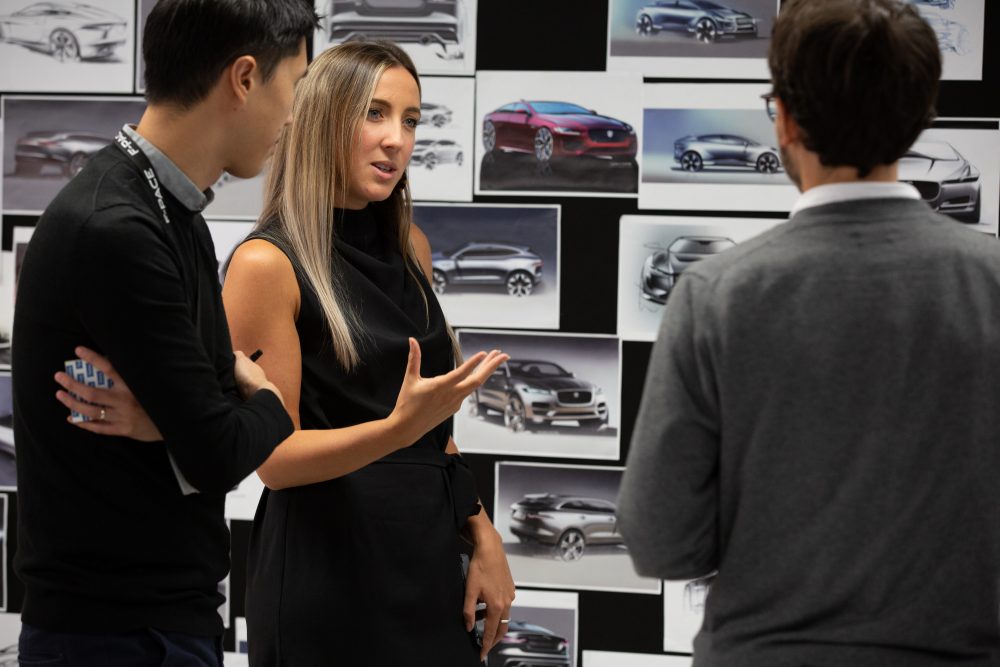
The DVA team continues to use virtual reality (VR) and augmented reality (AR) technologies throughout the process to compliment the physical clay models and digital sketches. When designs are at the initial concept stage, VR is used to create an immersive review process, helping designers settle on a direction or theme.
As a design evolves, VR and AR are used to advise on interior details such as headlinings, seat movements, active aerodynamics and the lighting and infotainment screen start-up sequences. This in-house technology and expertise allows Jaguar Design to be flexible and efficient, with amendments made in a fraction of the time required by a full model recreation. Mobile VR stations mean each project can be brought to life in real-time anywhere in the studio.
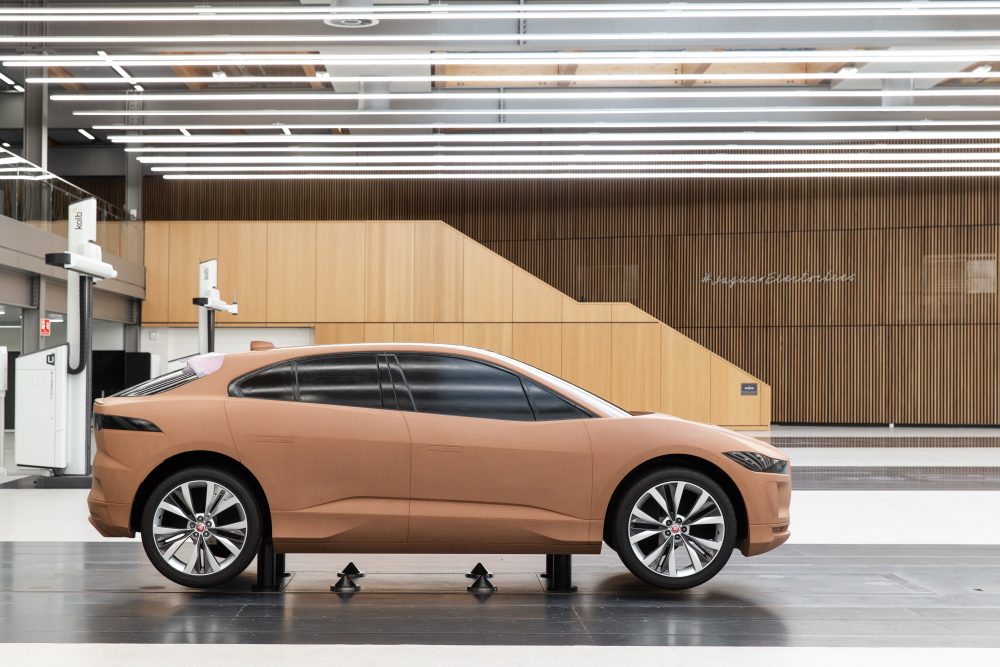
4. COLOUR AND MATERIALS – throughout the design process
The car design process extends beyond exterior and interior appearance, with tactility of materials vital to Jaguar Design. Sitting between the Interior and Exterior studio is the Colour and Materials team – a position that reflects its significance to both disciplines. Its role is focused on developing innovative new interior and exterior materials and finishes and is made up of experts from the world of automotive, fashion, jewellery and product design.
The team is involved throughout the design process – from sketching all the way to engineering – the Jaguar Colour & Materials Design team are continuously working to innovate and bring new, exciting and relevant design solutions into our vehicles. They touch every customer-facing surface to deliver a true Jaguar user experience. At the heart of its work sits Jaguar’s interpretation of ‘Britishness’ – an overwhelmingly positive and differentiating brand attribute – with the Colour and Materials team constantly evolving how this is woven into new vehicles. Individual members of the team hail from countries such as Sweden, Latvia, France and Italy, helping Jaguar to communicate what contemporary ‘Britishness’ means to customers across the world. Britishness is a dynamic concept and Jaguar Design embraces the innovative elegance and merging of past and future crafts and technologies to give its vehicles their unique character.
Megatrend research helps inform the team of ‘what’s next’ as well as helping predict the colour and materials that customers will want by the time a vehicle has finished its four-year design journey. The importance of this data means Colour and Materials plays an influential role throughout the process.

For the interior, the team takes inspiration for material innovation from other sectors including sportswear, product and architecture to bring new processes into automotive design. To ensure the materials meet Jaguar’s exacting standards, the team makes full-scale models, to fully demonstrate the new application of materials. These models work alongside VR and clay interiors to help the team finalise a design direction and bring the tactility of the vision to life.

The department is also driven by sustainability, championing new materials that deliver improved environmental credentials, both in use and supply, with transparent sourcing key to selecting the right materials. Jaguar strives to ensure all materials are durable in all conditions while enhancing the comfort of our vehicles. For example, seat upholstery is subjected to 60,000 cycles of abrasion resistance using the Martindale rub test, which simulates natural wear of a seat cover in everyday use.
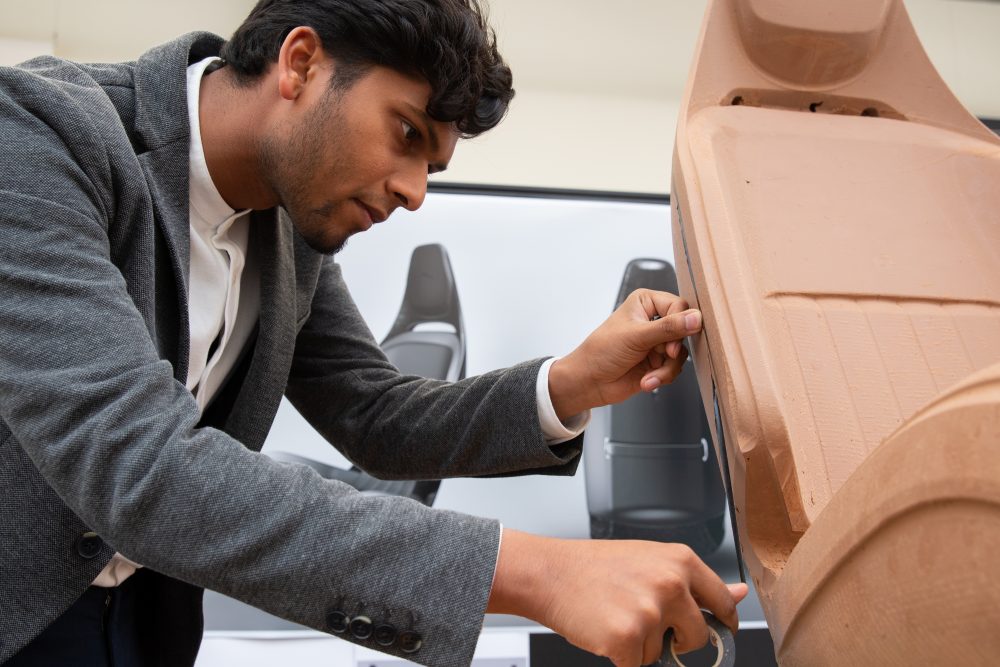
A key part of any vehicle design is the exterior with Colour and Materials responsible for developing new paint colours and material finishes. It takes four years to bring a new exterior colour to fruition.
Jaguar exterior paint testing follows a rigorous schedule to ensure that every aspect of the colour meets our expectations. This includes sending painted panels to Florida for two years’ exposure to strong sunlight, testing stone chip performance at -20 degrees C and adhesion after extended exposure to high humidity.

5. DESIGN TECHNICAL – throughout the design process
Design Technical looks at creative ways to deliver the team’s vision by developing design-enabling technologies and solutions from the very beginning of the process. This group of creative engineers sits at the centre of the design function to support the entire studio – helping to make even the most ambitious design a production reality.
The Advanced Design Technical (ADT) team work on whole vehicle layouts and architecture planning and form a key part of any project from the very outset.
Their job is to make sure the designs are feasible, identifying physical and legislative challenges and finding creative solutions to them with the aim of making the transition from sketchpad to production a smooth one. The team’s CAD expertise and understanding of the latest safety and sustainability requirements ensure the team is delivering plausible designs, covering everything from packaging and design-enabling tech to powertrain considerations.
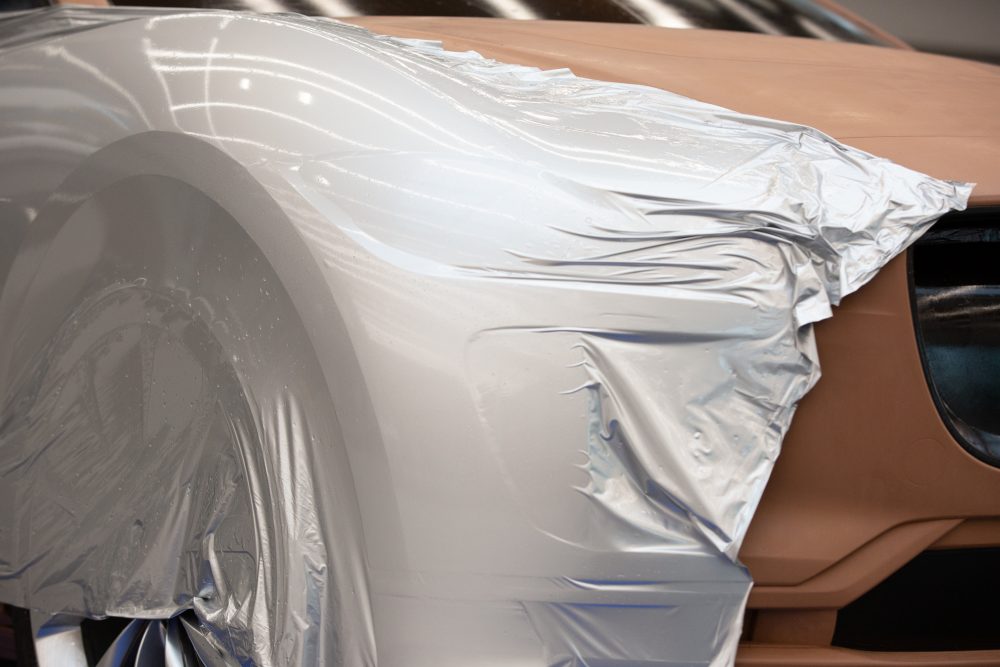
The ADT team’s integration within the new studio places them in Gaydon among the core engineering teams. This has accelerated the resolution of complex problems, making it easier to bring other business functions into the studio to help overcome technical challenges as they arise.
With the entire design function under one roof, within the same facility as the wider engineering team, the new studio is making the development process more fluid and organic at every step.
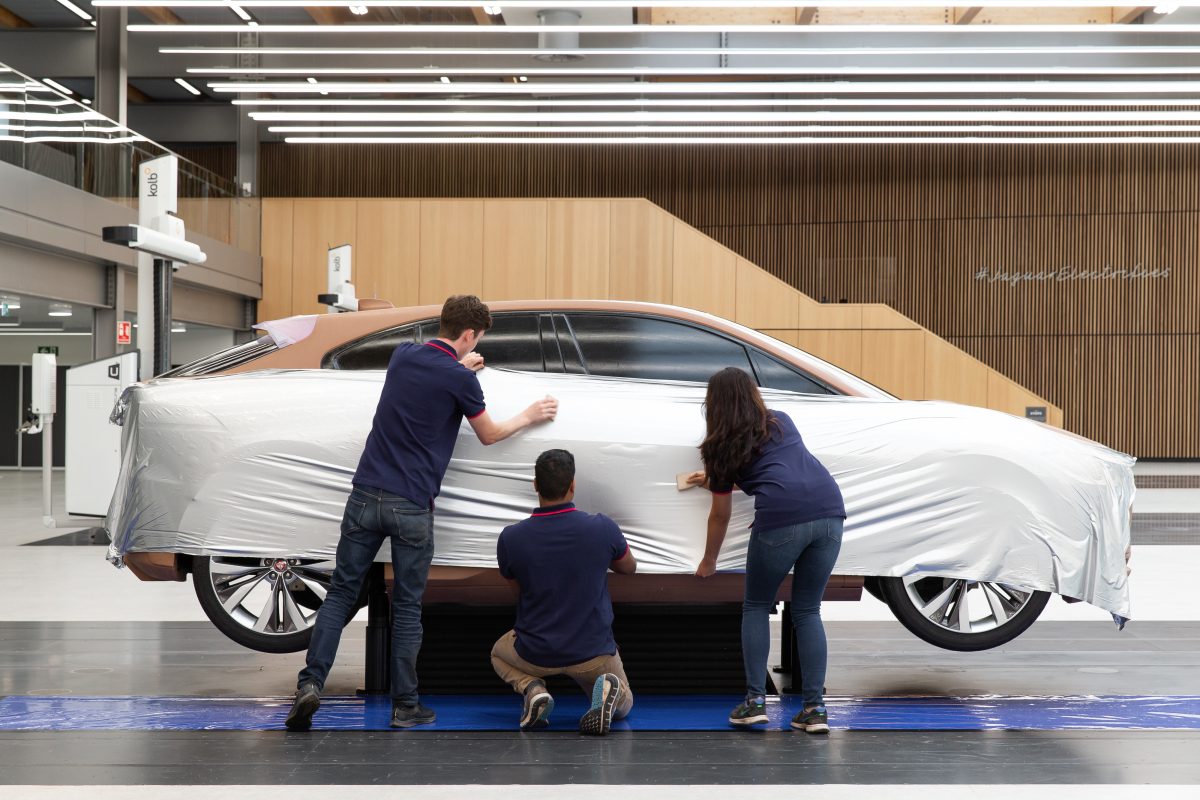
6. MODEL MANUFACTURE – typically four years before reveal (vision model)
The Jaguar Design Studio doesn’t just rely on clay sculpting to develop its vehicles; other full-scale models are created by the studio throughout the process. These interior and exterior models are used to evaluate size and proportion and are developed from initial concept sketches in the first six to 12 months.
When one design is selected as the ‘vision’, a new model is created from milled resin, with non-functioning 3D printed lamps, grilles, mirrors and wheels with unique trims, production quality paint and plexi-glass glazing. Alongside these exterior models, full-size interior vision properties are also created. With real seats, steering wheels and trimmed and painted surfaces beautifully finished to a ‘real’ aesthetic standard, these models help to focus the business and can be used for market research and to ensure all engineering tolerances are met.
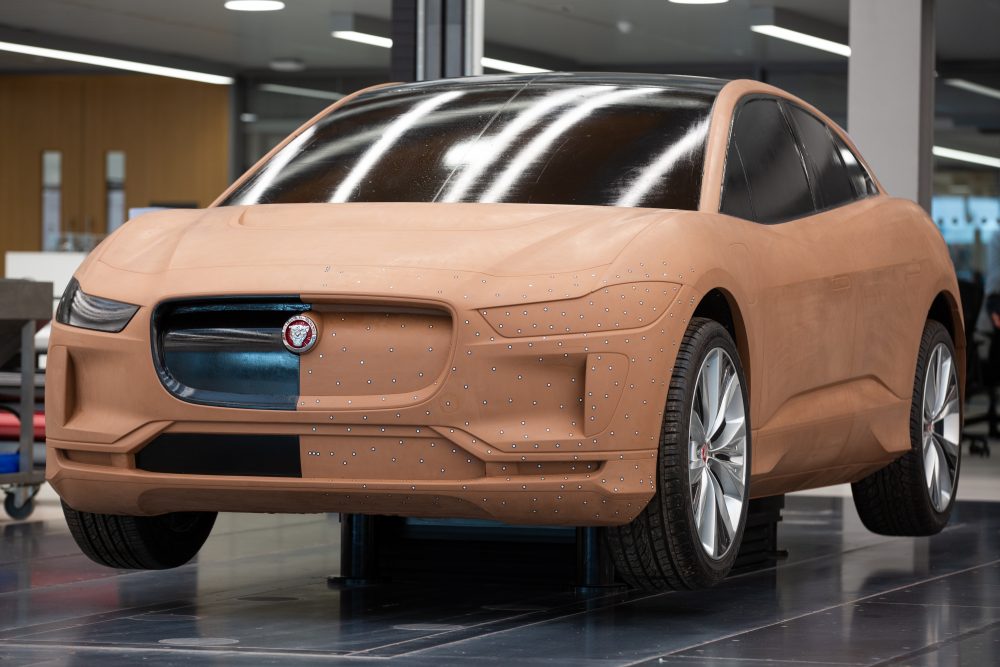
The step beyond the resin model is the exterior and interior Aesthetic Confirmation Models (ACM) produced when the design theme is frozen, the point at which clay modelling ends on the vehicle. The ACMs feature a higher level of detail such as milled metal components, functioning lamps, and are developed following design themes being refined and engineering feasibility work being completed.
The final model is the incredibly detailed Customer Design Reference Model – a full inside/outside driveable (low-speed) model created ahead of launch to showcase the vehicle before a full production version is available. It is built on a bespoke chassis with a body structure made up of a mix of carbon fibre and glass fibre, with fully functioning lamps, one-off machined aluminium wheels, and a fully trimmed interior complete with functioning displays.









